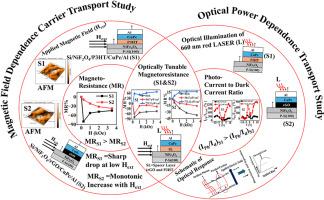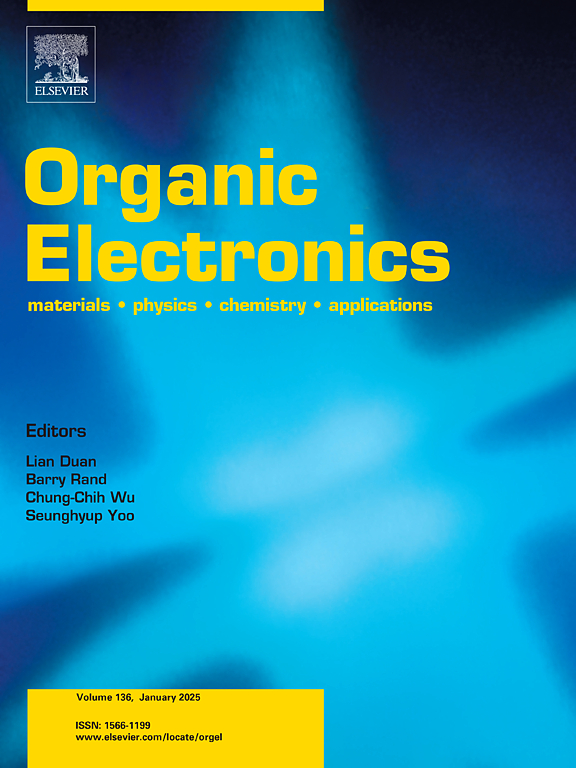Magneto-tunability of photocurrent in p-Si (100)/NiFe2O4/SL/CuPc/Al [where, spacer layer (SL)=P3HT and rGO] heterojunction devices at room temperature: Role of organic interface in Opto-spintronics
IF 2.6
4区 工程技术
Q3 MATERIALS SCIENCE, MULTIDISCIPLINARY
引用次数: 0
Abstract
Investigation of carrier transportation at ferromagnetic (FM)/organic semiconductor (OSC) interface has great research potential for the formation of spin valve (SV) device. Magneto-optical coupling effect on carriers has been investigated in FM/OSC based two heterostructures Silicon (Si)/Nickel ferrite (NiFe2O4)/poly (3-hexylthiophene) (P3HT)/Copper Phthalocyanine (CuPc)/Aluminium (Al) [P3HT based i.e., S1 heterostructure] and Si/NiFe2O4 (NFO)/reduced graphene oxide (rGO)/CuPc/Al [rGO based i.e, S2 heterostructure]. Direct spin injection and carrier transport mechanism are found to be prominent at the NFO/rGO interface due to very close position of conduction bands of NFO and rGO to the Fermi energy level, which results larger device current (1000 times larger than S1) in S2 sample. The S1 heterostructure exhibits a drastic increase in negative magnetoresistance (MR)at low magnetic field (Hext) regime due to enhancement of both de-pining spin from weak potential well and spin dependent tunneling of carriers at NFO/P3HT interface. However, at high Hext organic magnetoresistance (OMAR) effect of P3HT polymer results overall decrease of negative MR of S1 sample. In contrast, S2 device shows monotonic increase in negative MR. A significant photoresponse under 660 nm red laser has obtained in both the heterostructures. At high optical power, switching of MR from negative to positive value has been observed in both the devices, which attributes substantial scattering and decoherence of photogenerated carriers. Another side, on switching of Hext a drastic decrease and a monotonic decrease of photocurrent has been observed in S1 and S2 heterostructures, respectively, which comes from the modification of spin transportation at the interface.

室温下p-Si (100)/NiFe2O4/SL/CuPc/Al[其中,间隔层(SL)=P3HT和rGO]异质结器件中光电流的磁可调性:有机界面在光自旋电子学中的作用
研究铁磁(FM)/有机半导体(OSC)界面上的载流子输运对自旋阀(SV)器件的形成具有很大的研究潜力。研究了基于FM/OSC的两种异质结构硅(Si)/镍铁氧体(NiFe2O4)/聚(3-己基噻吩)(P3HT)/酞菁铜(CuPc)/铝(Al) [P3HT基即S1异质结构]和Si/NiFe2O4 (NFO)/还原氧化石墨烯(rGO)/CuPc/Al [rGO基即S2异质结构]对载流子的磁光耦合效应。由于NFO和rGO的导带与费米能级的位置非常接近,在NFO/rGO界面处存在明显的直接自旋注入和载流子输运机制,导致S2样品中的器件电流较大(比S1大1000倍)。S1异质结构在低磁场(Hext)下表现出显著的负磁电阻(MR)增加,这是由于弱势阱的去pin自旋和NFO/P3HT界面上载流子的自旋相关隧穿的增强。然而,在高邻域下,P3HT聚合物的有机磁阻(OMAR)效应导致S1样品的负磁阻总体下降。相反,S2器件的负mr呈单调增加,在660 nm红色激光下,两种异质结构都获得了显著的光响应。在高光功率下,两种器件都观察到MR从负值到正值的转换,这归因于光生载流子的大量散射和退相干。另一方面,在Hext开关时,在S1和S2异质结构中分别观察到光电流的急剧下降和单调下降,这是由于界面处自旋输运的改变。
本文章由计算机程序翻译,如有差异,请以英文原文为准。
求助全文
约1分钟内获得全文
求助全文
来源期刊

Organic Electronics
工程技术-材料科学:综合
CiteScore
6.60
自引率
6.20%
发文量
238
审稿时长
44 days
期刊介绍:
Organic Electronics is a journal whose primary interdisciplinary focus is on materials and phenomena related to organic devices such as light emitting diodes, thin film transistors, photovoltaic cells, sensors, memories, etc.
Papers suitable for publication in this journal cover such topics as photoconductive and electronic properties of organic materials, thin film structures and characterization in the context of organic devices, charge and exciton transport, organic electronic and optoelectronic devices.
 求助内容:
求助内容: 应助结果提醒方式:
应助结果提醒方式:


